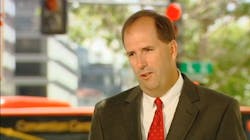You’d be forgiven for thinking that the unprecedented and history-making U.S. presidential victory by Donald Trump over Hillary Clinton – along with the retention of Congressional control of both the Senate and House of Representatives by the Republican Party – should make things easier on trucking from a regulatory perspective.
Maybe.
Then again, maybe not.
Recall that when George W. Bush won the U.S. presidential race back in 2000, many in trucking thought then-impending and still-contentious exhaust emission control rules for heavy trucks developed under President Bill Clinton’s administration might get delayed, if not changed to a dramatic degree.
Instead, they went into effect right on schedule in 2002 and wrapped up in 2010.
Efforts to improve trucking productivity by raising truck weight limits – again, another contentious move – also went nowhere. And continued to go nowhere during President Obama’s two terms.
Based on those experiences, then, those in the industry hoping to change or delay any of the regulations currently aimed at the industry, such as the upcoming electronic logging device (ELD) mandate, may be disappointed.
[As an aside, the recent court loss by the Owner-Operator Independent Drivers Assn. against the imposition of the ELD mandate pretty much seals the deal where that rule is concerned.]
That isn’t to say that a more truck-friendly regulatory approach isn’t possible. But it’s important to remember that the “regulatory approach” is really defined by what an incoming presidential administration puts at the top of its priority list – and let’s face it; trucking is rarely at the top of either political party’s priority list.
I recently talked about this with David Kelly, a longtime automotive industry expert who served as acting administrator for the National Highway Traffic Safety Administration (NHTSA) under President George W. Bush and now president of consulting firm Storm King Strategies.
“In a perfect world, it would take nine months to get a rulemaking done from beginning to end,” he explained. “The reality is that it takes one to two years and if the rule is controversial in any way, it’ll take a lot longer than two years.”
Another critical factor is how a proposed rule or change to a current rule fits into the policy priorities of a Presidential administration – and that “priority fit” is often what can turn a nine to 12 month rulemaking process into a two to four year effort, Kelly explained.
For instance, public transit became a much bigger focus during President Obama’s two terms compared to previous administrations – leading to major policy efforts by the Department of Transportation (DOT) in that arena
Priorities, too, are often dictated by where the money is, he added. For example, in transportation as a whole, rulemakings by the Federal Aviation Administration (FAA) and Federal Highway Administration (FHWA) will get more “process attention” from the White House simply because they represent the largest portions of transportation spending.
What spin will President-elect Trump and the Republican Party put on transportation issues? That remains to be seen, though the Republican Party platform issued back in July doesn’t bode well for passenger rail.
And it’s a long way to the inauguration next January. So no doubt a lot more transportation policy and priority twists are ahead for us.




